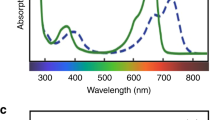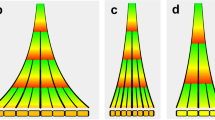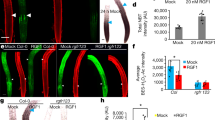Abstract
To generate the various tissues and organs that build up the adult body, plants and animals require organized formative cell divisions and correct cell specification. In plants, these processes are controlled mainly by phytohormones and transcriptional networks. Recently, ligand–receptor-like kinase signalling pathways have been revealed as additional potentially crucial regulators of cell specification in plants. We review here the importance of such signalling cascades for plant growth and development, and we discuss, where possible, similarities to well-investigated cascades in animals.
This is a preview of subscription content, access via your institution
Access options
Subscribe to this journal
Receive 12 print issues and online access
$209.00 per year
only $17.42 per issue
Buy this article
- Purchase on Springer Link
- Instant access to full article PDF
Prices may be subject to local taxes which are calculated during checkout




Similar content being viewed by others
References
Scheres, B. Stem-cell niches: nursery rhymes across kingdoms. Nature Rev. Mol. Cell Biol. 8, 345–354 (2007).
Scheres, B. & Benfey, P. N. Asymmetric Cell Division in Plants. Annu. Rev. Plant Physiol. Plant. Mol. Biol. 50, 505–537 (1999).
Berger, F., Haseloff, J., Schiefelbein, J. & Dolan, L. Positional information in root epidermis is defined during embryogenesis and acts in domains with strict boundaries. Curr. Biol. 8, 421–430 (1998).
van den Berg, C., Willemsen, V., Hage, W., Weisbeek, P. & Scheres, B. Cell fate in the Arabidopsis root meristem determined by directional signalling. Nature 378, 62–65 (1995).
Hubbard, S. R. & Miller, W. T. Receptor tyrosine kinases: mechanisms of activation and signaling. Curr. Opin. Cell Biol. 19, 117–123 (2007).
Schlessinger, J. Cell signaling by receptor tyrosine kinases. Cell 103, 211–225 (2000).
Bhalerao, R. P. & Bennett, M. J. The case for morphogens in plants. Nature Cell Biol. 5, 939–943 (2003).
Smith, J. C., Hagemann, A., Saka, Y. & Williams, P. H. Understanding how morphogens work. Philos. Trans. R. Soc. Lond. B. Biol. Sci. 363, 1387–1392 (2008).
De Smet, I. & Jürgens, G. Patterning the axis in plants - auxin in control. Curr. Opin. Genet. Dev. 17, 337–343 (2007).
Kurata, T., Okada, K. & Wada, T. Intercellular movement of transcription factors. Curr. Opin. Plant Biol. 8, 600–605 (2005).
Lau, S., Jürgens, G. & De Smet, I. The evolving complexity of the auxin pathway. Plant Cell 20, 1738–1746 (2008).
Tanaka, H., Dhonukshe, P., Brewer, P. B. & Friml, J. Spatiotemporal asymmetric auxin distribution: a means to coordinate plant development. Cell Mol. Life Sci. 63, 2738–2754 (2006).
Matsubayashi, Y. & Sakagami, Y. Peptide hormones in plants. Annu. Rev. Plant Biol. 57, 649–674 (2006).
Butenko, M. A., Vie, A. K., Brembu, T., Aalen, R. B. & Bones, A. M. Plant peptides in signalling: looking for new partners. Trends Plant Sci. 14, 255–263 (2009).
Mitchum, M. G., Wang, X. & Davis, E. L. Diverse and conserved roles of CLE peptides. Curr. Opin. Plant Biol. 11, 75–81 (2008).
Shiu, S. H. & Bleecker, A. B. Plant receptor-like kinase gene family: diversity, function, and signaling. Sci. STKE 2001, RE22 (2001).
Oh, M. H. et al. Tyrosine phosphorylation of the BRI1 receptor kinase emerges as a component of brassinosteroid signaling in Arabidopsis. Proc. Natl Acad. Sci. USA 106, 658–663 (2009).
Lease, K. A. & Walker, J. C. The Arabidopsis unannotated secreted peptide database, a resource for plant peptidomics. Plant Physiol. 142, 831–838 (2006).
Parniske, M. Arbuscular mycorrhiza: the mother of plant root endosymbioses. Nature Rev. Microbiol. 6, 763–775 (2008).
Afzal, A. J., Wood, A. J. & Lightfoot, D. A. Plant receptor-like serine threonine kinases: roles in signaling and plant defense. Mol. Plant Microbe Interact. 21, 507–517 (2008).
Takayama, S. & Isogai, A. Self-incompatibility in plants. Annu. Rev. Plant Biol. 56, 467–489 (2005).
Belkhadir, Y., Wang, X. & Chory, J. Brassinosteroid signaling pathway. Sci. STKE 2006, cm4 (2006).
Hematy, K. & Hofte, H. Novel receptor kinases involved in growth regulation. Curr. Opin. Plant Biol. 11, 321–328 (2008).
Clark, S. E. Cell signalling at the shoot meristem. Nature Rev. Mol. Cell Biol. 2, 276–284 (2001).
Stahl, Y. & Simon, R. Plant stem cell niches. Int. J. Dev. Biol. 49, 479–489 (2005).
Ogawa, M., Shinohara, H., Sakagami, Y. & Matsubayashi, Y. Arabidopsis CLV3 peptide directly binds CLV1 ectodomain. Science 319, 294 (2008).
Clark, S. E., Running, M. P. & Meyerowitz, E. M. CLAVATA1, a regulator of meristem and flower development in Arabidopsis. Development 119, 397–418 (1993).
Dievart, A. et al. CLAVATA1 dominant-negative alleles reveal functional overlap between multiple receptor kinases that regulate meristem and organ development. Plant Cell 15, 1198–1211 (2003).
DeYoung, B. J. et al. The CLAVATA1-related BAM1, BAM2 and BAM3 receptor kinase-like proteins are required for meristem function in Arabidopsis. Plant J. 45, 1–16 (2006).
DeYoung, B. J. & Clark, S. E. BAM receptors regulate stem cell specification and organ development through complex interactions with CLAVATA signaling. Genetics 180, 895–904 (2008).
Miwa, H. et al. The receptor-like kinase SOL2 mediates CLE signaling in Arabidopsis. Plant Cell Physiol. 49, 1752–1757 (2008).
Müller, R., Bleckmann, A. & Simon, R. The receptor kinase CORYNE of Arabidopsis transmits the stem cell-limiting signal CLAVATA3 independently of CLAVATA1. Plant Cell 20, 934–946 (2008).
Inoue, T. et al. C. elegans LIN-18 is a Ryk ortholog and functions in parallel to LIN-17/Frizzled in Wnt signaling. Cell 118, 795–806 (2004).
Nodine, M. D., Yadegari, R. & Tax, F. E. RPK1 and TOAD2 are two receptor-like kinases redundantly required for Arabidopsis embryonic pattern formation. Dev. Cell 12, 943–956 (2007).
De Smet, I. et al. Receptor-like kinase ACR4 restricts formative cell divisions in the Arabidopsis root. Science 322, 594–597 (2008).
Stahl, Y., Wink, R. H., Ingram, G. C. & Simon, R. A Signaling Module Controlling the stem cell niche in Arabidopsis Root Meristems. Curr. Biol. 19, 909–914 (2009).
Cao, X., Li, K., Suh, S. G., Guo, T. & Becraft, P. W. Molecular analysis of the CRINKLY4 gene family in Arabidopsis thaliana. Planta 220, 645–657 (2005).
Stokes, K. D. & Gururaj Rao, A. Dimerization properties of the transmembrane domains of Arabidopsis CRINKLY4 receptor-like kinase and homologs. Arch. Biochem. Biophys. 477, 219–226 (2008).
Gifford, M. L., Robertson, F. C., Soares, D. C. & Ingram, G. C. ARABIDOPSIS CRINKLY4 function, internalization, and turnover are dependent on the extracellular crinkly repeat domain. Plant Cell 17, 1154–1166 (2005).
Tsuwamoto, R., Fukuoka, H. & Takahata, Y. GASSHO1 and GASSHO2 encoding a putative leucine-rich repeat transmembrane-type receptor kinase are essential for the normal development of the epidermal surface in Arabidopsis embryos. Plant J. 54, 30–42 (2008).
Casamitjana-Martinez, E. et al. Root-specific CLE19 overexpression and the sol1/2 suppressors implicate a CLV-like pathway in the control of Arabidopsis root meristem maintenance. Curr. Biol. 13, 1435–1441 (2003).
Fiers, M. et al. Mis-expression of the CLV3/ESR-like gene CLE19 in Arabidopsis leads to a consumption of root meristem. Gene 327, 37–49 (2004).
Hobe, M., Muller, R., Grunewald, M., Brand, U. & Simon, R. Loss of CLE40, a protein functionally equivalent to the stem cell restricting signal CLV3, enhances root waving in Arabidopsis. Dev. Genes Evol. 213, 371–381 (2003).
Fiers, M. et al. The 14-amino acid CLV3, CLE19, and CLE40 peptides trigger consumption of the root meristem in Arabidopsis through a CLAVATA2-dependent pathway. Plant Cell 17, 2542–2553 (2005).
Fiers, M., Ku, K. L. & Liu, C. M. CLE peptide ligands and their roles in establishing meristems. Curr. Opin. Plant Biol. 10, 39–43 (2007).
Savaldi-Goldstein, S., Peto, C. & Chory, J. The epidermis both drives and restricts plant shoot growth. Nature 446, 199–202 (2007).
Becraft, P. W., Stinard, P. S. & McCarty, D. R. CRINKLY4: A TNFR-like receptor kinase involved in maize epidermal differentiation. Science 273, 1406–1409 (1996).
Gifford, M. L., Dean, S. & Ingram, G. C. The Arabidopsis ACR4 gene plays a role in cell layer organisation during ovule integument and sepal margin development. Development 130, 4249–4258 (2003).
Watanabe, M., Tanaka, H., Watanabe, D., Machida, C. & Machida, Y. The ACR4 receptor-like kinase is required for surface formation of epidermis-related tissues in Arabidopsis thaliana. Plant J. 39, 298–308 (2004).
Tanaka, H. et al. Novel receptor-like kinase ALE2 controls shoot development by specifying epidermis in Arabidopsis. Development 134, 1643–1652 (2007).
Nodine, M. D. & Tax, F. E. Two receptor-like kinases required together for the establishment of Arabidopsis cotyledon primordia. Dev. Biol. 314, 161–170 (2008).
Tanaka, H. et al. A subtilisin-like serine protease is required for epidermal surface formation in Arabidopsis embryos and juvenile plants. Development 128, 4681–4689 (2001).
Steiner, D. F. The proprotein convertases. Curr. Opin. Chem. Biol. 2, 31–39 (1998).
Chevalier, D. et al. STRUBBELIG defines a receptor kinase-mediated signaling pathway regulating organ development in Arabidopsis. Proc. Natl Acad. Sci. USA 102, 9074–9079 (2005).
Yadav, R. K., Fulton, L., Batoux, M. & Schneitz, K. The Arabidopsis receptor-like kinase STRUBBELIG mediates inter-cell-layer signaling during floral development. Dev. Biol. 323, 261–270 (2008).
Yarden, Y. & Sliwkowski, M. X. Untangling the ErbB signalling network. Nature Rev. Mol. Cell Biol. 2, 127–137 (2001).
Kwak, S. H. & Schiefelbein, J. The role of the SCRAMBLED receptor-like kinase in patterning the Arabidopsis root epidermis. Dev. Biol. 302, 118–131 (2007).
Kwak, S. H., Shen, R. & Schiefelbein, J. Positional signaling mediated by a receptor-like kinase in Arabidopsis. Science 307, 1111–1113 (2005).
Dolan, L. & Roberts, K. The development of cell pattern in the root epidermis. Philos. Trans. R. Soc. Lond. B. Biol. Sci. 350, 95–99 (1995).
Kwak, S. H. & Schiefelbein, J. A feedback mechanism controlling SCRAMBLED receptor accumulation and cell-type pattern in Arabidopsis. Curr. Biol. 18, 1949–1954 (2008).
Kuppusamy, K. T., Chen, A. Y. & Nemhauser, J. L. Steroids are required for epidermal cell fate establishment in Arabidopsis roots. Proc. Natl Acad. Sci. USA 106, 8073–8076 (2009).
Casson, S. & Gray, J. E. Influence of environmental factors on stomatal development. New Phytol. 178, 9–23 (2008).
Geisler, M., Nadeau, J. & Sack, F. D. Oriented asymmetric divisions that generate the stomatal spacing pattern in Arabidopsis are disrupted by the too many mouths mutation. Plant Cell 12, 2075–2086 (2000).
Nadeau, J. A. & Sack, F. D. Control of stomatal distribution on the Arabidopsis leaf surface. Science 296, 1697–1700 (2002).
Shpak, E. D., McAbee, J. M., Pillitteri, L. J. & Torii, K. U. Stomatal patterning and differentiation by synergistic interactions of receptor kinases. Science 309, 290–293 (2005).
Hara, K., Kajita, R., Torii, K. U., Bergmann, D. C. & Kakimoto, T. The secretory peptide gene EPF1 enforces the stomatal one-cell-spacing rule. Genes Dev. 21, 1720–1725 (2007).
Hunt, L. & Gray, J. E. The Signaling Peptide EPF2 Controls Asymmetric Cell Divisions during Stomatal Development. Curr. Biol. 19, 864–869 (2009).
Hara, K. et al. Epidermal cell density is autoregulated via a secretory peptide, EPIDERMAL PATTERNING FACTOR 2 in Arabidopsis leaves. Plant Cell Physiol. 50, 1019–1031 (2009).
Berger, D. & Altmann, T. A subtilisin-like serine protease involved in the regulation of stomatal density and distribution in Arabidopsis thaliana. Genes Dev. 14, 1119–1131 (2000).
Von Groll, U., Berger, D. & Altmann, T. The subtilisin-like serine protease SDD1 mediates cell-to-cell signaling during Arabidopsis stomatal development. Plant Cell 14, 1527–1539 (2002).
Cartwright, H. N., Humphries, J. A. & Smith, L. G. PAN1: a receptor-like protein that promotes polarization of an asymmetric cell division in maize. Science 323, 649–651 (2009).
Ye, Z. H. Vascular tissue differentiation and pattern formation in plants. Annu. Rev. Plant Biol. 53, 183–202 (2002).
Fisher, K. & Turner, S. PXY, a receptor-like kinase essential for maintaining polarity during plant vascular-tissue development. Curr. Biol. 17, 1061–1066 (2007).
Hirakawa, Y. et al. Non-cell-autonomous control of vascular stem cell fate by a CLE peptide/receptor system. Proc. Natl Acad. Sci. USA 105, 15208–15213 (2008).
Ito, Y. et al. Dodeca-CLE peptides as suppressors of plant stem cell differentiation. Science 313, 842–845 (2006).
Whitford, R., Fernandez, A., De Groodt, R., Ortega, E. & Hilson, P. Plant CLE peptides from two distinct functional classes synergistically induce division of vascular cells. Proc. Natl Acad. Sci. USA 105, 18625–18630 (2008).
Boavida, L. C., Becker, J. D. & Feijo, J. A. The making of gametes in higher plants. Int. J. Dev. Biol. 49, 595–614 (2005).
Canales, C., Bhatt, A. M., Scott, R. & Dickinson, H. EXS, a putative LRR receptor kinase, regulates male germline cell number and tapetal identity and promotes seed development in Arabidopsis. Curr. Biol. 12, 1718–1727 (2002).
Jia, G., Liu, X., Owen, H. A. & Zhao, D. Signaling of cell fate determination by the TPD1 small protein and EMS1 receptor kinase. Proc. Natl Acad. Sci. U SA 105, 2220–2225 (2008).
Yang, S. L. et al. Overexpression of TAPETUM DETERMINANT1 alters the cell fates in the Arabidopsis carpel and tapetum via genetic interaction with EXCESS MICROSPOROCYTES1/EXTRA SPOROGENOUS CELLS. Plant Physiol. 139, 186–191 (2005).
Yang, S. L. et al. TAPETUM DETERMINANT1 is required for cell specialization in the Arabidopsis anther. Plant Cell 15, 2792–2804 (2003).
Zhao, D. Z., Wang, G. F., Speal, B. & Ma, H. The excess microsporocytes1 gene encodes a putative leucine-rich repeat receptor protein kinase that controls somatic and reproductive cell fates in the Arabidopsis anther. Genes Dev. 16, 2021–2031 (2002).
Zhao, X. et al. OsTDL1A binds to the LRR domain of rice receptor kinase MSP1, and is required to limit sporocyte numbers. Plant J. 54, 375–387 (2008).
Hord, C. L., Chen, C., Deyoung, B. J., Clark, S. E. & Ma, H. The BAM1/BAM2 receptor-like kinases are important regulators of Arabidopsis early anther development. Plant Cell 18, 1667–1680 (2006).
Colcombet, J., Boisson-Dernier, A., Ros-Palau, R., Vera, C. E. & Schroeder, J. I. Arabidopsis SOMATIC EMBRYOGENESIS RECEPTOR KINASES1 and 2 are essential for tapetum development and microspore maturation. Plant Cell 17, 3350–3361 (2005).
Mizuno, S. et al. Receptor-like protein kinase 2 (RPK 2) is a novel factor controlling anther development in Arabidopsis thaliana. Plant J. 50, 751–766 (2007).
Geldner, N., Hyman, D. L., Wang, X., Schumacher, K. & Chory, J. Endosomal signaling of plant steroid receptor kinase BRI1. Genes Dev. 21, 1598–1602 (2007).
Le Roy, C. & Wrana, J. L. Clathrin- and non-clathrin-mediated endocytic regulation of cell signalling. Nature Rev. Mol. Cell Biol. 6, 112–126 (2005).
Robert, S. et al. Endosidin1 defines a compartment involved in endocytosis of the brassinosteroid receptor BRI1 and the auxin transporters PIN2 and AUX1. Proc. Natl Acad. Sci. USA 105, 8464–8469 (2008).
Baass, P. C., Di Guglielmo, G. M., Authier, F., Posner, B. I. & Bergeron, J. J. Compartmentalized signal transduction by receptor tyrosine kinases. Trends Cell Biol. 5, 465–470 (1995).
Taub, N., Teis, D., Ebner, H. L., Hess, M. W. & Huber, L. A. Late endosomal traffic of the epidermal growth factor receptor ensures spatial and temporal fidelity of mitogen-activated protein kinase signaling. Mol. Biol. Cell 18, 4698–4710 (2007).
Robatzek, S., Chinchilla, D. & Boller, T. Ligand-induced endocytosis of the pattern recognition receptor FLS2 in Arabidopsis. Genes Dev. 20, 537–542 (2006).
Russinova, E. et al. Heterodimerization and endocytosis of Arabidopsis brassinosteroid receptors BRI1 and AtSERK3 (BAK1). Plant Cell 16, 3216–3229 (2004).
Gendron, J. M. & Wang, Z. Y. Multiple mechanisms modulate brassinosteroid signaling. Curr. Opin. Plant. Biol. 10, 436–441 (2007).
Santner, A., Calderon-Villalobos, L. I. & Estelle, M. Plant hormones are versatile chemical regulators of plant growth. Nature Chem. Biol. 5, 301–307 (2009).
Lukowitz, W., Roeder, A., Parmenter, D. & Somerville, C. A MAPKK kinase gene regulates extra-embryonic cell fate in Arabidopsis. Cell 116, 109–119 (2004).
Bayer, M. et al. Paternal control of embryonic patterning in Arabidopsis thaliana. Science 323, 1485–1488 (2009).
Tang, W. et al. BSKs mediate signal transduction from the receptor kinase BRI1 in Arabidopsis. Science 321, 557–560 (2008).
Kim, T.-W. et al. Brassinosteroid signal transduction from cell-surface receptor kinases to nuclear transcription factors. Nature Cell Biol. 11, 1254–1260 (2009).
van Zanten, M., Snoek, L. B., Proveniers, M. C. & Peeters, A. J. The many functions of ERECTA. Trends Plant Sci. 14, 214–218 (2009).
Li, J. et al. BAK1, an Arabidopsis LRR receptor-like protein kinase, interacts with BRI1 and modulates brassinosteroid signaling. Cell 110, 213–222 (2002).
Chinchilla, D. et al. A flagellin-induced complex of the receptor FLS2 and BAK1 initiates plant defence. Nature 448, 497–500 (2007).
De Rybel, B. et al. Chemical inhibition of a subset of Arabidopsis thaliana GSK3-like kinases activates brassinosteroid signaling. Chem. Biol. 16, 594–604 (2009).
Gregan, J. et al. Construction of conditional analog-sensitive kinase alleles in the fission yeast Schizosaccharomyces pombe. Nature Protoc. 2, 2996–3000 (2007).
Acknowledgements
We thank G. V. Isterdael for assistance in producing the figures and S. Lau, A. Renault, A. Maier and two anonymous referees for critical comments. We wish to apologize to those whose contributions we could not include because of space limitations. This work was supported by the European Molecular Biology organization (postdoctoral fellowship EMBO-ALTF 108-2006 to I.D.S.), Marie Curie Intra-European Fellowship scheme (postdoctoral fellowship FP6 MEIF-CT-2007-041375 to I.D.S.), the Deutsche Forschungsgemeinschaft (Ju 179/12-1 and AFGN 179/15-1 to G.J.), and by grants from the Interuniversity Poles of Attraction Program — Belgian Science Policy (Barn contract) to T.B.
Author information
Authors and Affiliations
Corresponding author
Rights and permissions
About this article
Cite this article
De Smet, I., Voß, U., Jürgens, G. et al. Receptor-like kinases shape the plant. Nat Cell Biol 11, 1166–1173 (2009). https://doi.org/10.1038/ncb1009-1166
Issue Date:
DOI: https://doi.org/10.1038/ncb1009-1166
This article is cited by
-
Crystal structure of DRIK1, a stress-responsive receptor-like pseudokinase, reveals the molecular basis for the absence of ATP binding
BMC Plant Biology (2020)
-
Transcriptional analyses of differential cultivars during resistant and susceptible interactions with Peronospora effusa, the causal agent of spinach downy mildew
Scientific Reports (2020)
-
Characterization on the water deprivation-associated physiological traits as well as the related differential genes during seed filling stage in wheat (T. aestivum L.)
Plant Cell, Tissue and Organ Culture (PCTOC) (2020)
-
Long-term in vitro culture affects phenotypic plasticity of Neoregelia johannis plants
Plant Cell, Tissue and Organ Culture (PCTOC) (2019)
-
SUMO conjugation to the pattern recognition receptor FLS2 triggers intracellular signalling in plant innate immunity
Nature Communications (2018)



